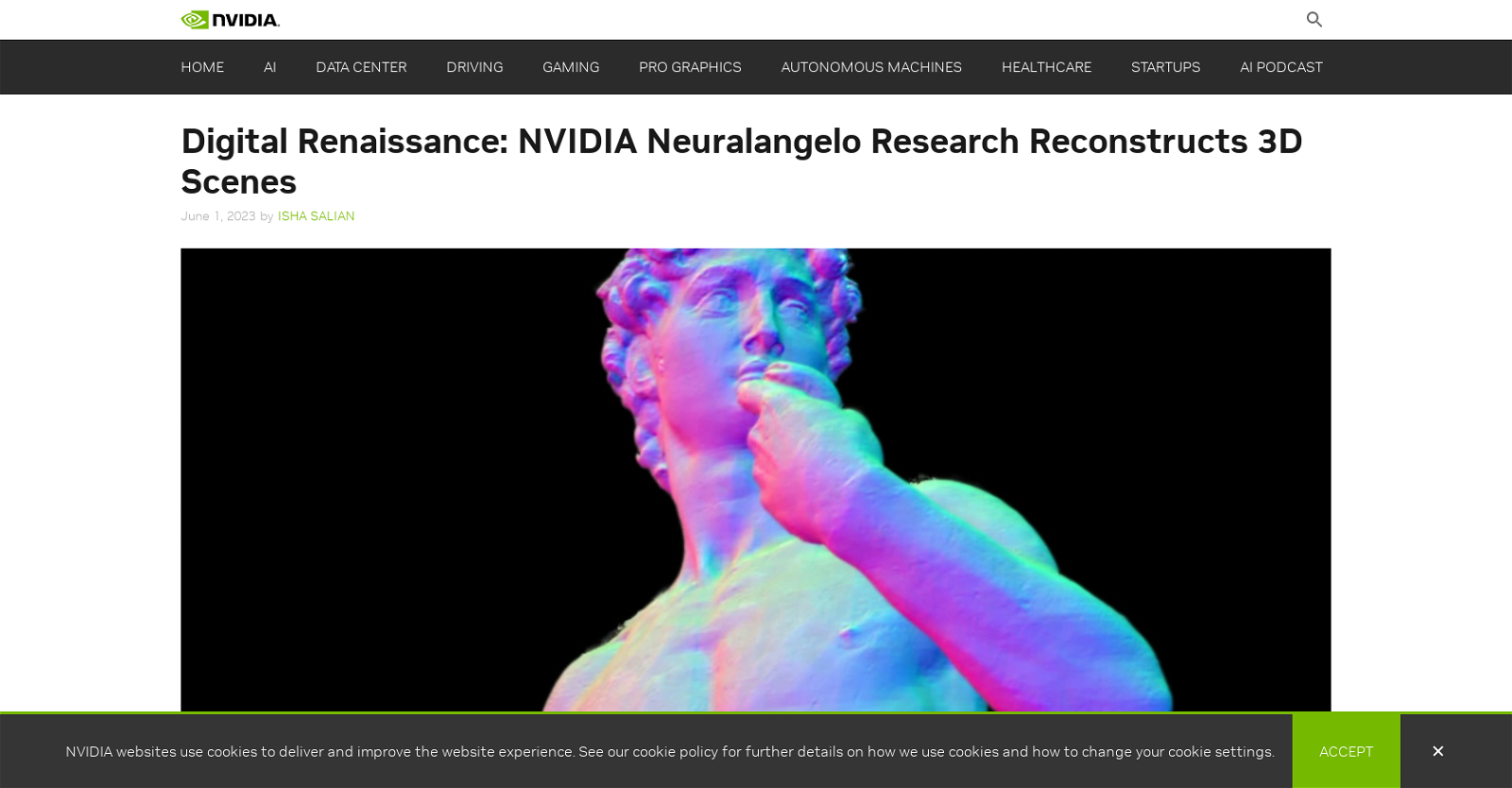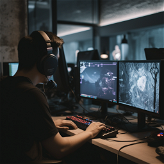What is Neuralangelo by Nvidia?
Neuralangelo by Nvidia is an AI model that specializes in 3D reconstruction using neural networks. The model can generate virtual replicas of real-world objects from 2D video clips. These objects range from small statues to large buildings, with intricate details and textures.
How does Neuralangelo create 3D models from 2D videos?
Neuralangelo creates 3D models from 2D videos through a multi-stage process. First, it selects frames from the 2D video captured from various angles. After determining the camera position for each frame, it uses these perspectives to create a rough 3D representation of the scene. The model then optimizes this rough render to sharpen its details, resulting in a faithful 3D reconstruction.
What industries can benefit from using Neuralangelo?
A wide range of industries can benefit from using Neuralangelo. These include creative professionals in art and video game development, where it can aid in the creation of detailed virtual objects or environments. Additionally, parties working on industrial digital twins - virtual representations of real-world objects or processes - can use the model to recreate details of the real world in the digital space.
What kind of details can Neuralangelo capture in 3D reconstruction?
Neuralangelo can capture intricate details during 3D reconstruction. It can handle repetitive texture patterns, homogenous colors, and strong color variations. It uses technology called instant neural graphics primitives, which help it to capture these finer details, resulting is high-fidelity recreations.
What complex materials textures can Neuralangelo translate from 2D videos to 3D assets?
Neuralangelo can translate complex material textures, including roof shingles, panes of glass, and smooth marble from 2D videos to 3D assets.
How does Neuralangelo's high fidelity simplify creating virtual objects?
Neuralangelo's high fidelity simplifies the creation of virtual objects by providing highly accurate, detailed 3D reconstructions. These renderings are sophisticated and refined enough to quickly be utilized in projects using footage captured by devices as common as smartphones.
Why is Neuralangelo used in video game development and industrial digital twins?
Neuralangelo is used in video game development and industrial digital twins to import highly detailed objects into virtual environments, aiding in the recreation of the real-world within the digital one. This allows for the creation of immersive gaming environments and accurate, reliable digital twins for industries.
How does Neuralangelo use instant neural graphics primitives?
Neuralangelo uses instant neural graphics primitives technology, which allows it to capture finer details in the 3D reconstruction process. This technology aids in accurately representing features such as repetitive texture patterns, homogenous colors, and strong color variations.
What is the process of Neuralangelo optimizing a 3D representation to sharpen the details?
Neuralangelo refines the initial rough 3D representation of the scene by optimizing its render to sharpen the details. This process works similarly to a sculptor refining the texture of a statue, allowing the model to create a more precise and detailed 3D object.
Can Neuralangelo be used in virtual reality applications?
Yes, Neuralangelo can be used in virtual reality applications. Using Neuralangelo's detailed 3D models, developers can create lifelike virtual environments that users can explore in virtual reality.
How is Neuralangelo used in robotics development?
Neuralangelo can be used in robotics development to create precise 3D models of objects and scenes, which are essential for areas such as object recognition, navigation, and manipulation tasks in robotics.
What kind of real-world objects can I recreate with Neuralangelo?
With Neuralangelo, you can recreate a wide variety of real-world objects, ranging from small statues to massive buildings, each rendered with intricate details and textures.
How can Neuralangelo benefit creative professionals?
Neuralangelo can significantly benefit creative professionals by permitting them to generate lifelike virtual replicas of real-world objects with intricate details, which they can import into design applications for further editing and enhancement as needed, speeding up their creative process.
What is the precision of Neuralangelo's 3D reconstruction?
The precision of Neuralangelo's 3D reconstruction is high, as exhibited by its ability to translate intricate details, complex material textures and significant color variations from 2D videos into highly detailed 3D assets.
How does Neuralangelo select frames for creating a rough 3D representation?
Neuralangelo selects frames from a 2D video by considering the image from various angles, similar to how an artist evaluates a subject from multiple sides to understand its depth, size, and shape. This helps it create a more accurate initial 3D representation of the scene or object.
What improvements does Neuralangelo have over prior 3D reconstruction methods?
Neuralangelo surpasses prior 3D reconstruction methods in its ability to translate complex material textures from 2D videos to 3D assets, effectively capturing and recreating intricate details and textures. Also, its high-fidelity renderings are immediately usable in various applications, thus accelerating project timelines.
Can Neuralangelo handle repetitive texture patterns and color variations?
Yes, Neuralangelo is capable of handling repetitive texture patterns and color variations. It uses instant neural graphics primitives to capture these finer details during 3D reconstruction, which contributes to the high fidelity of its rendered models.
How does Neuralangelo handle 3D reconstruction of large-scale scenes?
Neuralangelo handles the 3D reconstruction of large-scale scenes by leveraging its technology to capture various details like texture patterns and color variations. It initially creates a rough 3D representation of the scene and then optimizes it, enhancing the details to synthesize a more accurate and complete 3D model.
Can I import the 3D objects created by Neuralangelo into other design applications?
Yes, you can import the 3D objects created by Neuralangelo. These detailed objects can be further edited in various design applications, making them suitable for uses in a range of industries including art, video game development, and industrial digital twins.
What kind of footage can be used as input for 3D reconstruction using Neuralangelo?
As input for 3D reconstruction, Neuralangelo can use footage captured by various devices, including smartphones. This flexibility makes it practical and versatile as it means detailed 3D models can be created from readily accessible sources of 2D video footage.













